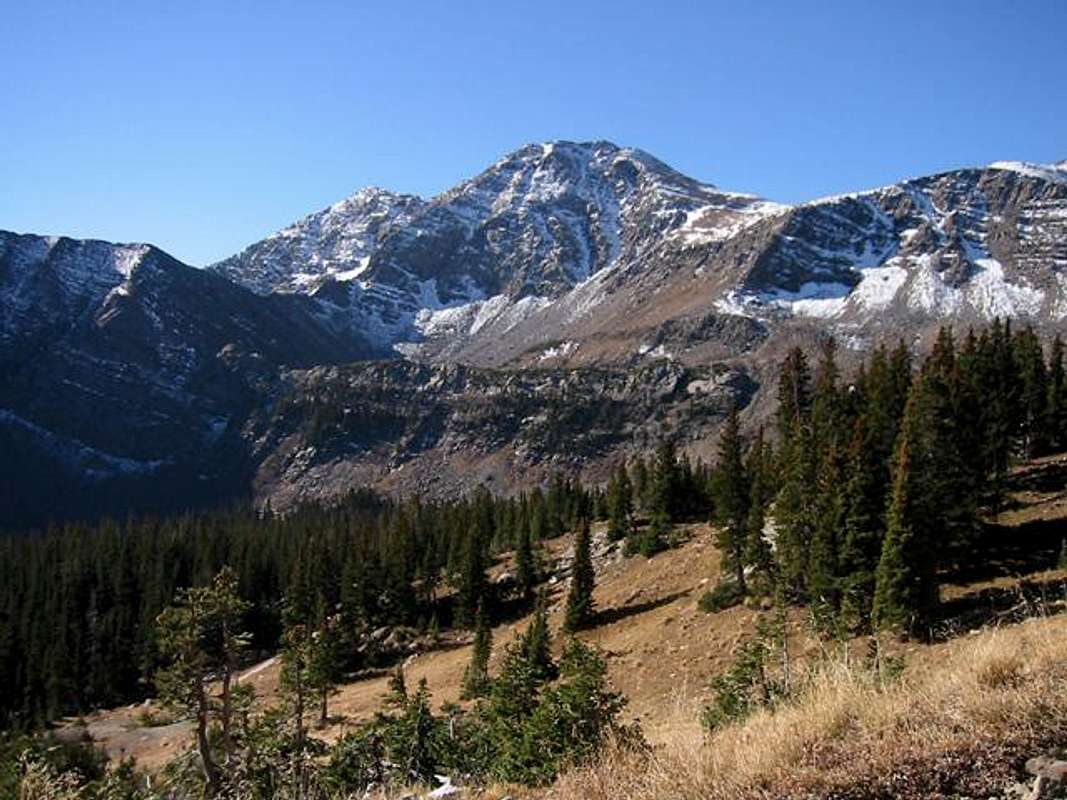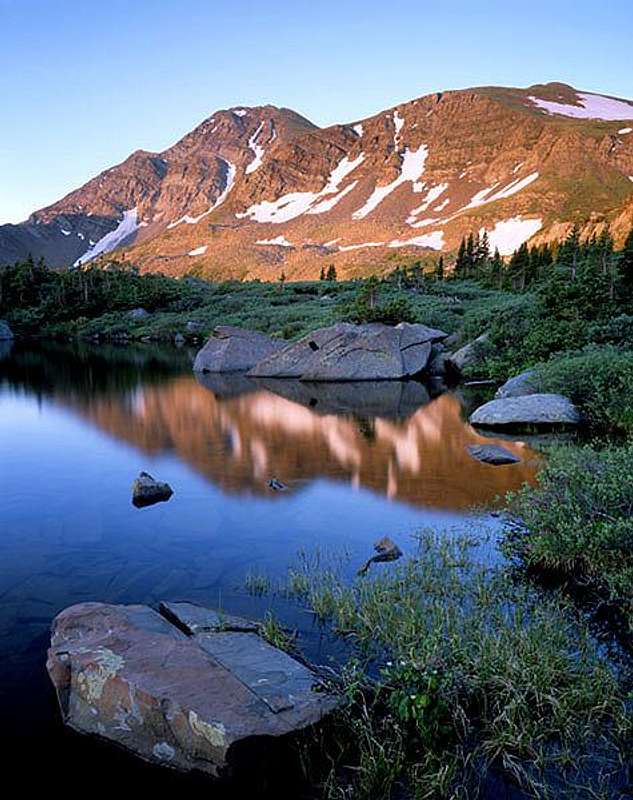-
 28031 Hits
28031 Hits
-
 86.67% Score
86.67% Score
-
 23 Votes
23 Votes
|
|
Mountain/Rock |
|---|---|
|
|
38.07900°N / 105.64°W |
|
|
13489 ft / 4111 m |
|
|
Sangre de Cristo Mountains Overview

Eureka Mountain from a tarn along the Hermit Pass Road. Photo by Brent D
The Sangre de Cristo Mountains are one of the most distinct subranges of Colorado's Rocky Mountains. They rise as a nearly continous straight line from near Salida, Colorado and run overer 100 miles to end near Sante fe, New Mexico. They are seperated from adjacent ranges by the San Luis Valley on the west and Wet Mountain Valley on the east. The Sangre de Cristos are more rugged than their Sawatch bretheren to the north west and a distinct geology differentiates them from the San Juans to the west. The sharp peaks and solid sedimentary rock of the central Sangre de Cristos distiguishes it as a place like no other in Colorado.
The Sangre de Cristo Mountains are in large part protected by the 226,455 acre Sangre de Cristo Wilderness, designated in 1993; and the Great Sand Dunes National Park. Thanks in part to the legal protections granted by the Wilderness Act large portions of the Sangres remain relatively pristene.
- Sangre de Cristo Geology: The Sangre de Cristo Mountains are a Fault Block Mountain Range. Their history can be traced back to the Ancestral Rocky Mountains that rose as a chain of mountainous islands running roughly from the northeast to the southwest across Colorado 300 million years ago. As these ancient mountains were ground down by the forces of erosion, sediments carried off by ancient river systems built up large deposits in the Central Colorado Trough, a large basin between the Uncompaghre Highlands and the Front Range Highlands.
In the vicinity of the Sangre de Cristos a formation called the Crestone Conglomerate was the result of the erosion of these mountains. The conglomerate is an alluvial deposit of rounded boulders, cobles, and stones imbedded in a sandstone matrix, it was dropped by swift moving streams and rivers as they exited the mountains and entered a shallow sea. It is solid and erosion resistent. Contemporaneous sedimentary deposits compose the Fountain Formation, of Red Rocks and the Flat Irons, and the Maroon Formation of the Elk Mountains. These coarse deposits were subsequently burried by younger sediments. They laid deep underground for 235 million years.
Beginning 65 million years ago the Laramide Orogeny began thrusting sections of Colorado towards the heavens. Whereas the rock of the Sawatch and Mosquito Mountains to the north bent upward as broad curves, the Sangre de Cristos first bent, then broke along several faults. As the uplift pressed the core of the Sangres against the pre-existing Wet Mountains the resulting pressure thrust the Sangres westward. The same faults that pushed the Sangres away from the Wet Mountains reactivated 26 million years ago (as the Rio Grand Rift awoke dormant faults throught Colorado, and creating all the Great Mountain Parks in the process) dropping the Wet Mountain Valley and the San Luis Valley in relation to the soaring peaks. The rocks presently exposed range from the Precambrian basement rocks in the northern and southern (Sierra Blanca) portions of the range, the central sections are composed predominantly of 300 million year old Crestone Conglomerate, and 23 million year old intrusive stocks make up the Spanish Peaks.
Begining 1.8 million years ago and continuing up until 20,000 years ago, glaciation scoured the mountainscape. Headwalls were steepened, valleys broadened, and aretes carved. Evidence of the action of glaciers is evident from the presence of big u-shaped valleys joined by hanging valleys, often connected by small waterfalls as at Willow Lake. It is seen in on exposed rock surfaces polished and striated by the patient motion of mountain glaciers. Morraines, piles of material glaciers eroded from the surrounding mountains and dropped as a contoured wall of debris as the glacier receded from its last advance, choke many of the drainages of the Sangre de Cristos, requiring an ascent of a steep, loose hill on route to the upper basins. These same morraines often shelter high alpine lakes which occupy the broad basins and shelves the glaciers carved. The effects of this Ice Age artistry rendered the unique geology of the Sangres into the sculpted forms that exist today.
- Flora and Fauna: The Sangres system of narrow valleys seperated by rugged ridges creates a constrained ecology that seems well suited to the discreet little oases they occupy. The vegatative growth seldom shows the large old trees (except perhaps in the Heurfano River Valley) seen in the Elks or Front Range. The aspen, though abundant, are often smaller of girth and darker of bark then the massive apen stands of the Elks or San Juans. The high peaks are frequently decorated durring the summer months with a verdant velvet of grass that grows in wonderful wave patterns dictated by the geology of the rock. The flora of the Sangres is interesting for its distinct differences...
The wildlife of the Sangre de Cristos is also worth mentioning as you cannot triapse around this range long without encountering its native denizens. Marmots, Pika, and Alpine Voles are abundant in all drainages. In areas where marmots have gotten used to people, they are to be feared. Coyotes and Pine Martins prey on these animals. Elk, Whitetailed Deer, Bighorn Sheep, and Mountain Goats are the large herbivores. Black Bears and Mountain Lions are also present. Precautions should be taken for storing food in a manner that won't attract the bruins.
Eureka Mountain Overview

Eureka Mountain in October as seen from the Hermit Pass Road.
Eureka Mountain is a central member of the Crestone Conglomerate portion of the Sangre de Cristos. It is a distinctly beautiful mountain that stands out amongst its attractive neighbors.
Eureka Mountain is in the heart of the narrow Sangre de Cristo Wilderness yet it can be easily accessed be the Hermit Pass Road The delightful traverse from the pass reminds is a very aesthetic way to climb the mountain. The route features spectacular sceney, slabby and fun conglomeritic rock, and a great summit. A more wild approach is possible from the west.
Directions and Maps
Camping and Attractions

Eureka Mountain sunrise. Photo by Brent D










